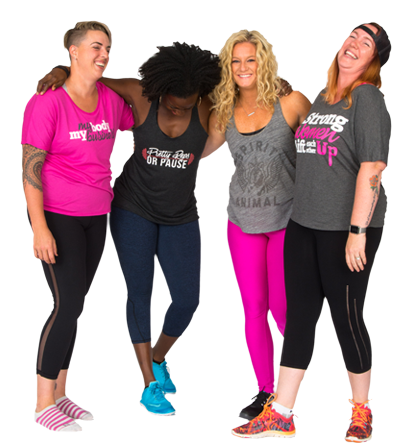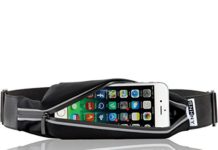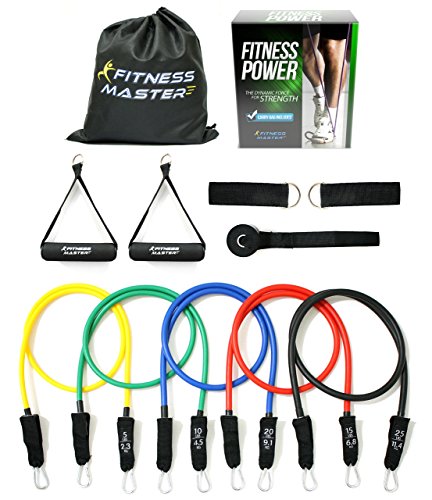As you’ve scoured the Internet throughout the course of your fitness journey, have you ever used the Google image search engine? I know I have. I’ve used it to find pictures of specific muscles and proper lifting form, and even cute fitness attire, among many other things. When we search for images, we are often looking for representative images of that person, object, or idea. We tend to see the top search results as the “truest” or best representations of whatever it is that we’re looking for.
Now, do a Google image search for “fit woman.”
I’ll wait. What do you see?
More than likely, you’re looking at dozens of images reflecting a very similar look.
Now repeat the search with “healthy woman.” Again, you see a very similar and consistent image.
While none of these women are problematic themselves, the problem lies in who is not there and what that says about the way we frame our visions of fitness.
Visual imagery is powerful, particularly in fitness culture. It reflects, perpetuates, and creates norms that we internalize about fitness. If we consistently see images of the same thing, we begin to believe that that recurring image is the standard or the definition. This can be dangerous for those who are taking their first steps toward changing their activity and self-care practices.
Register for the Women’s Strength and Empowerment Weekend!
Spots are going fast, and it always sells out!
Intersectionality 101
Feminists, particularly women of color, had been advocating for a more complex analysis of women’s multiple identities for years, but it was black feminist legal scholar Dr. Kimberlé Crenshaw who coined and theorized intersectionality to give meaning to the ways that identities and their oppressions overlap.1 Crenshaw investigated a court case in which a group of black woman argued that because they were both black and women they were unable to access jobs within their company. The judge dismissed their complaint, pointing out that black men were working in the factory and (white) women were working in the front office. What the judge failed to see was how they were being uniquely discriminated against for being both black and women.
 Now, imagine an asterisk with many lines. Each of those lines represents one aspect of your identity. These lines will represent, minimally, race, ethnicity, gender, sex, sexuality, age, ability, and religion, to name a few. The point in the center at which all those lines cross is you.
Now, imagine an asterisk with many lines. Each of those lines represents one aspect of your identity. These lines will represent, minimally, race, ethnicity, gender, sex, sexuality, age, ability, and religion, to name a few. The point in the center at which all those lines cross is you.
Intersectionality insists that examining women’s experiences through a lens of gender alone is not enough because how we experience womanhood is shaped by these other parts of our identities.
Maybe you’re aware of how you experience all these identities. Maybe not. But, what intersectionality asks us to do is consider how other women might experience those identities in profoundly different ways. While as women we may share some important common experiences, there are so many variables that can potentially make our lives very different from one another.
Intersectionality And Fitness
So, what does intersectionality have to do with fitness? Actually, a lot! How we “see” fitness culture and fit bodies is profoundly shaped by the imagery and advice that dominates magazines covers, advertisements, meal plan suggestions, and fitness routines, as well as by our own lives. Importantly, these dominant messages about fitness also inform the assumptions that are made about what we have access to, our time constraints, what we value, and what we desire for ourselves.
 Looking back at the Google image search of “fit woman,” we can see a recurring image of a white woman with low body fat, visible muscles, an hourglass figure, no visible physical disabilities, feminine characteristics, and trendy workout gear, with access to well-equipped gyms. There is a particular aesthetic that is associated with being a fit woman that we have been told represents fitness, and while these women are arguably fit, it renders invisible the multitudes of women who embody fitness but don’t reflect those images in any way.
Looking back at the Google image search of “fit woman,” we can see a recurring image of a white woman with low body fat, visible muscles, an hourglass figure, no visible physical disabilities, feminine characteristics, and trendy workout gear, with access to well-equipped gyms. There is a particular aesthetic that is associated with being a fit woman that we have been told represents fitness, and while these women are arguably fit, it renders invisible the multitudes of women who embody fitness but don’t reflect those images in any way.
When we step into a gym, onto the sidewalk for a run, or into a grocery store to buy food for our meal prep, we bring along with us complex identities that influence the choices we make or that determine whether or not we even have those choices. I am profoundly aware of myself as a woman of color when I walk into certain grocery stores, and I am reminded of my own experiences as a formerly poor brown woman who grew up thinking that certain foods, such as fresh cherries, were “white.”
 No one in particular said this to me or made me feel this way, but because cherries were expensive, and I lived in a racially tense part of Texas where many of the Latinos I knew were poor, I conflated economic struggle with race. And while it was just a perception, it was still strong and meaningful enough to shape how I saw food and to influence my actual diet. Intersectionality has given me a more complex understanding of how race, class, and food interacted in ways that made certain foods seem inaccessible to me.
No one in particular said this to me or made me feel this way, but because cherries were expensive, and I lived in a racially tense part of Texas where many of the Latinos I knew were poor, I conflated economic struggle with race. And while it was just a perception, it was still strong and meaningful enough to shape how I saw food and to influence my actual diet. Intersectionality has given me a more complex understanding of how race, class, and food interacted in ways that made certain foods seem inaccessible to me.
Using an intersectional lens to look at my physical environment has also made me more critical about fitness advice. Oftentimes advice columns on how to “get fit on a budget” recommend that women just “strap on those walking shoes and take a walk around your neighborhood!” While this sounds like an enjoyable and low-cost way of exercising, it’s not ideal for neighborhoods where women feel vulnerable to danger or where, in my case, there are inadequate sidewalks and loose dogs. If outdoor exercise is not common in your neighborhood, it’s easy to feel like a spectacle. When my husband, a high school teacher, mentioned to his female student that he enjoyed running at the nearby community park, she asked, “Aren’t you embarrassed?” Clearly for this student, a young Latina, exercising in public made her feel vulnerable and subject to the public gaze.
Examining and Redefining Symbols of Fitness
As many of us who have been in the game for so long know, the bodies we see as symbols of fitness take serious work, time, and resources to achieve.
Simply “wanting it enough” is, quite bluntly, not enough for women with inadequate access to clean resources and good grocery stores; with little control over their physical or home environments; who feel vulnerable as ethnic, sexual, or gender minorities in their fitness space or who have demanding jobs that are physically draining.
Add to this a lack of transportation, the demands of juggling multiple roles as mothers and spouses, or living with disability, and it’s easy to see how the bulk of what is recommended or prescribed has a specific audience in mind and is exploiting the pressures women face to look like the fitness norm.
Something I often hear from my students when I talk about the power of imagery is, “Well, I don’t pay attention to those things. They don’t affect me!” But in her powerful documentary, “Killing Us Softly 4,” feminist scholar Jean Kilbourne reveals that only eight percent of an image’s message is received by the conscious mind.2 This means that we are vastly unaware of the impact an image has on our consciousness!
 That is a big deal, because it is at that level of consciousness that we normalize concepts like beauty, health, and race. In other words, we come to see certain representations or ideas as being the “normal” or “right” way to be.
That is a big deal, because it is at that level of consciousness that we normalize concepts like beauty, health, and race. In other words, we come to see certain representations or ideas as being the “normal” or “right” way to be.
Black women have been blogging about this for years, pointing out how normalizing thin, white bodies can subsequently masculinize black women’s bodies, such as those of Serena Williams and Gabby Douglas. Looking more closely at some of the practices of fitness culture, such as tanning and the “build a better booty” movement, we should think critically about the fact that black women have not always been able to enjoy having bountiful backsides or dark bodies because of sexual and racial stigma. An intersectional approach to fitness reminds us that we can’t divorce race from gender, sexuality, and body type in how we see and shape our (and others’) bodies.
Whose Space Is It, Really?
We often cheer each other on to take up space, but depending on who we are or what we look like, we won’t take up space the same way. For Muslim women, for example, religion and gender intersect in ways that create different experiences of fitness. Wearing clothing or head coverings that comply with their religious beliefs may disqualify them from certain competitions, or may subject them to harassment in spaces that others may find to be welcoming and inclusive.
Queer women and gender nonconforming folks have also expressed feeling alienated, policed, and unsafe in gyms.
Gyms, of all places, should be spaces where patrons feel safe and empowered.
But if you don’t perform femininity in ways that don’t fit the norm, such as by choosing not to shave your underarms, or if you are transgender, you can face hostility.
So what does this mean for all of us? Just looking at the Girls Gone Strong Facebook page, I see a growing representation of diverse women across race, ethnicity, age, sexuality, and ability. We need to continue working toward broadening our ideas of fitness so that they are more inclusive, attainable, and in touch with our identities and lived realities as women. Using intersectionality to understand the differences in our fitness experiences leads to a more inclusive vision in our efforts to build communities and cultures of fitness.
How To Be The Change
Below is a preliminary list of tips for developing and adopting intersectionally minded fitness practices for fitness professionals, and everyone.
Tips for trainers, gym owners, and fitness marketers:
- Strive for diverse images and anecdotes in your marketing materials, instructional videos, and fitness literature. Provide a wide representation of race, gender expression, class, ability, and religion.
- Ask for your clients’ pronouns and names. Make it a standard part of your sign-up forms. Also consider gender-neutral restrooms and showers.
- Ask your clients to describe their environments and come up with a plan for exercising on days they can’t make it to the gym that is sensitive to those environments.
- When discussing eating, don’t make assumptions about access to grocery stores and transportation; fresh food is difficult to keep on hand if grocery stores are not close by.
- Ask your client what kinds of foods are important to them and that they like to eat. Asking that they avoid a food that is closely linked to their identity may negatively affect their relationship with food. (Read more about giving culturally sensitive nutrition advice in this article by Erika Kendall.)
- Beware of clichés! Fitspirational posters urging folks to “move more” might be frustrating for clientele who have disabilities or who work physically demanding jobs, such as hotel housekeepers or manufacturing plant workers.
- Make it a point to connect your client with other clients or people in your fitness community with whom they may identify more personally.
- Consider a sliding pay scale; if this is not possible for you right now, perhaps create a program where clients with more resources can donate to support clients with financial challenges.
For everyone:
- When people of color, queer folks, disabled folks, or other marginalized communities create exclusive spaces to practice fitness, be supportive! There is a reason why they feel it is important to have their own space.
- If a friend does not feel comfortable training in a certain gym or space, offer to accompany them or suggest a new place where you can work out together.
- Avoid romanticizing others’ bodies: your Latina friend’s “curvy” body, your black friend’s generous behind, or your Asian friend’s lithe frame may be enviable to you but may have complicated histories for them.
- Be careful with the language you use to describe body shape: boy-shaped, womanly, and manly are phrases that are not only unscientific, but they can misgender others or can remind others of an identity that they no longer identify with.
- Read your favorite fitness magazines and blogs with a critical eye. Asking ourselves questions about what we consume keeps us in control of how media makes us feel or what it encourages us to believe.
- Avoid clichés such as “No pain, no gain,” which can be dangerous for those with chronic pain or illness.
- Offer to babysit! The lack of childcare can be a major deterrent to going to the gym for women who are mothers.
- Be compassionate.
If fitness seems a lot more complicated than it did before—good! Understanding how intersectional identities create difference and shape experience can lead to a more empathetic trainer-client relationship, and can help us engage in our own and each others’ fitness journeys more meaningfully and compassionately.
Save $200! Early bird price for the Women’s Strength & Empowerment Weekend ends soon!
The Women’s Strength and Empowerment Weekend, powered by Girls Gone Strong, was designed to create a space for women to rise, teach, lead, learn, and connect with one another. Throughout the weekend you’ll hear from some of the most well-respected women in the world from every facet of the health and wellness industry, from PhDs to Registered Dietitians to top CrossFit athletes, and pre and postnatal fitness and body autonomy experts.

You’ll be surrounded by a group of like-minded, strong women who are there to lift each other up, and help each other become the best version of themselves in a warm, welcoming, and inclusive environment.
You will leave the weekend feeling heard, loved, supported, and empowered and most importantly knowing that you have finally found your tribe.
Last year we sold out in just 26 hours, so if you’re interested in attending, click the button below.
References
- Crenshaw, K. Mapping the Margins: Intersectionality, Identity Politics, and Violence against Women of Color. Stanford Law Review. 1991. 43:1241-1299.
- Kilbourne, J. Killing Us Softly 4: Advertising’s Image of Women. The Media Education Foundation. (Study guide here)
The post Who Gets to be Fit? Working out the Intersections of Fitness appeared first on Girls Gone Strong.






